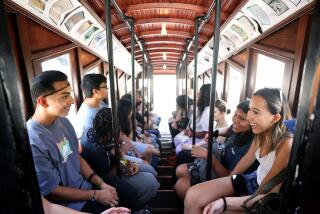World-Class Goodby : Exchange Students Go Home to a New Order
The cry came from the crowd. The tears came from German visitor Julika Mayer’s eyes.
“We love you, Julika! We’ll never forget you!” teen-agers shouted to her Wednesday across a parking lot at El Segundo High School.
After living for a year with a family in Riverside, 17-year-old Mayer was headed for the airport and a trip home to Nuremberg, West Germany. Other teens who had come to Los Angeles last summer as foreign exchange students were sadly waving goodby to a friend they probably would never see again.
Mayer dropped her bags and ran, sobbing, back onto the school grounds. She gave a last hug to Loma Botha, 19, of South Africa; Ana Baldisserotto, 17, of Brazil; and Tomislav Zelenovic, 18, of Yugoslavia.
They were among 650 high school students from 59 countries who ended their American visits in an emotional final meeting at the campus, picked for its proximity to Los Angeles International Airport.
During the year, the 90 teens visiting Southland homes would frequently gather for potluck dinners or excursions to places such as the Grand Canyon.
Wednesday’s departure was especially bittersweet for teen-agers such as Mayer, Botha, Zelenovic and other natives of countries that have undergone major political changes in the last year.
Never in the 43-year history of the exchange program have so many visiting students returned home “facing an entirely new world order,” said Craig Brown, West Coast director of AFS Intercultural Programs, which sponsored the visits.
“These students are going home to see what has happened for themselves. They are going home to become the leaders and healers of tomorrow,” Brown said.
Nida Afsar, 17, of West Berlin did not hide her excitement.
“I’m very anxious to get back home,” she said. “The first thing I want to do is walk through the Brandenburg Gate. That’s been the symbol of separation for us.”
Afsar said she was glued to her host family’s television set in Monterey when the Berlin Wall fell late last year: “I watched it all day . . . watching people dancing on the wall. I knew my friends back home were up there.”
Soviet exchange student Simon Dzhanashia admitted to some anxiety about returning home, where new freedoms are being balanced by new economic challenges. “I’ll have to wait and see whether it’s better or not,” he said.
During his year with the Frank Grant family of Altadena, he fit in easily with fellow students at Pasadena Polytechnic High School, said Dzhanashia, 15, of Tbilisi.
“They were great. They were interested in what’s going on back there,” he said of his fellow high schoolers. “They’d ask if we really have long lines for food and if people back there really wear dull clothing. I got used to it.”
The United States was also a learning experience for them, other exchange students admitted.
Eighteen-year-old Juhana Laurila, a budding artist from Helsinki, Finland, quickly learned to change the name of his art form when he arrived to live with the Bruce Johnston family of Long Beach. “In Finland, I used the word ‘graffiti’ for my art,” Laurila said. “Here, people who hear that word think you are a gang member. So I started telling everybody I was a ‘muralist.’ ”
For Trine Boetkjaer, 16, of Skanderborg, Denmark, her year’s stay in the desert community of Barstow took some getting used to initially.
More to Read
Sign up for Essential California
The most important California stories and recommendations in your inbox every morning.
You may occasionally receive promotional content from the Los Angeles Times.











